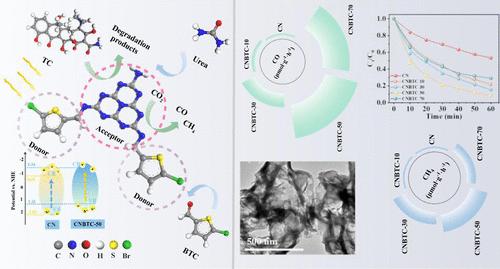Our official English website, www.x-mol.net, welcomes your
feedback! (Note: you will need to create a separate account there.)
Enhancing Internal Electric Field of Metal-Free Donor–Acceptor Conjugated Photocatalysts for Efficient Photocatalytic Degradation of Tetracycline and CO2 Reduction
Langmuir ( IF 3.7 ) Pub Date : 2024-11-19 , DOI: 10.1021/acs.langmuir.4c03632 Guangyu Wu, Geng Li, Yonggong Tang, Guoyu Tai, Yuwei Pan, Jiangang Han, Weinan Xing
Langmuir ( IF 3.7 ) Pub Date : 2024-11-19 , DOI: 10.1021/acs.langmuir.4c03632 Guangyu Wu, Geng Li, Yonggong Tang, Guoyu Tai, Yuwei Pan, Jiangang Han, Weinan Xing

|
Constructing alternating donor–acceptor (D–A) units within g-C3N4 represents an effective strategy for enhancing photocatalytic performance through improved charge carrier separation while concurrently addressing energy shortages and facilitating wastewater remediation. Here, a series of D–A-type conjugated photocatalysts (CNBTC-X) are prepared using g-C3N4 as an acceptor unit and different masses of 5-bromo-2-thiophenecarboxaldehyde (BTC) as a donor unit by a one-step thermal polymerization. CNBTC-50 presents higher photocatalytic properties for CO2 reduction coupled with tetracycline (TC) removal than those of g-C3N4, CNBTC-10, CNBTC-30, and CNBTC-70. The introduction of the unique electron-donor–acceptor structure effectively drives the separation and transfer of photoinduced carriers while reducing the internal carrier transfer hindrance. Photocatalytic experiments reveal that the CNBTC-50 photocatalyst achieves up to 94.6% TC removal under visible light irradiation conditions. Compared with that of the pristine g-C3N4, the photocatalytic degradation reaction rate constant of CNBTC-50 is significantly increased by about 3.87 times. The study examines the influence of various reaction parameters on degradation activity, including catalyst concentration, pH, and TC concentration. Additionally, LC–MS is utilized to perform a comprehensive analysis of the intermediates and pathways involved in TC degradation. Furthermore, CNBTC-50 demonstrates remarkable photocatalytic CO2 reduction activity, achieving rates of 20.83 μmol g–1 h–1 (CO) and 9.36 μmol g–1 h–1 (CH4), which are 10.68 and 5.98 times more efficient than those of g-C3N4, respectively. This work aims to offer valuable guidance for the rational design of nonmetal D–A-structured catalysts and effectively integrates reaction systems to couple CO2 reduction with antibiotic removal.
中文翻译:

增强无金属供体-受体共轭光催化剂的内部电场,以实现四环素的高效光催化降解和 CO2 还原
在 g-C3N4 中构建交替的供体-受体 (D-A) 单元是一种通过改进电荷载流子分离来提高光催化性能的有效策略,同时解决能源短缺和促进废水修复。在这里,以 g-C3N4 为受体单元,以不同质量的 5-溴-2-噻吩甲醛 (BTC) 为供体单元,通过一步热聚合制备了一系列 D-A 型共轭光催化剂 (CNBTC-X)。CNBTC-50 在 CO2 还原和去除四环素 (TC) 方面表现出比 g-C3N4、CNBTC-10、CNBTC-30 和 CNBTC-70 更高的光催化性能。独特的电子-供体-受体结构的引入有效地推动了光诱导载流子的分离和转移,同时减少了内部载流子转移障碍。光催化实验表明,CNBTC-50 光催化剂在可见光照射条件下可实现高达 94.6% 的 TC 去除率。与原始 g-C3N4 相比,CNBTC-50 的光催化降解反应速率常数显著提高了约 3.87 倍。该研究考察了各种反应参数对降解活性的影响,包括催化剂浓度、pH 值和 TC 浓度。此外,LC-MS 还用于对 TC 降解所涉及的中间体和途径进行全面分析。此外,CNBTC-50 表现出显著的光催化 CO2 还原活性,达到 20.83 μmol g-1 h-1 (CO) 和 9.36 μmol g-1 h-1 (CH4),即 10.68 和 5。效率分别是 g-C3N4 的 98 倍。这项工作旨在为非金属 D-A 结构催化剂的合理设计提供有价值的指导,并有效地整合反应系统以耦合 CO2 还原与抗生素去除。
更新日期:2024-11-19
中文翻译:

增强无金属供体-受体共轭光催化剂的内部电场,以实现四环素的高效光催化降解和 CO2 还原
在 g-C3N4 中构建交替的供体-受体 (D-A) 单元是一种通过改进电荷载流子分离来提高光催化性能的有效策略,同时解决能源短缺和促进废水修复。在这里,以 g-C3N4 为受体单元,以不同质量的 5-溴-2-噻吩甲醛 (BTC) 为供体单元,通过一步热聚合制备了一系列 D-A 型共轭光催化剂 (CNBTC-X)。CNBTC-50 在 CO2 还原和去除四环素 (TC) 方面表现出比 g-C3N4、CNBTC-10、CNBTC-30 和 CNBTC-70 更高的光催化性能。独特的电子-供体-受体结构的引入有效地推动了光诱导载流子的分离和转移,同时减少了内部载流子转移障碍。光催化实验表明,CNBTC-50 光催化剂在可见光照射条件下可实现高达 94.6% 的 TC 去除率。与原始 g-C3N4 相比,CNBTC-50 的光催化降解反应速率常数显著提高了约 3.87 倍。该研究考察了各种反应参数对降解活性的影响,包括催化剂浓度、pH 值和 TC 浓度。此外,LC-MS 还用于对 TC 降解所涉及的中间体和途径进行全面分析。此外,CNBTC-50 表现出显著的光催化 CO2 还原活性,达到 20.83 μmol g-1 h-1 (CO) 和 9.36 μmol g-1 h-1 (CH4),即 10.68 和 5。效率分别是 g-C3N4 的 98 倍。这项工作旨在为非金属 D-A 结构催化剂的合理设计提供有价值的指导,并有效地整合反应系统以耦合 CO2 还原与抗生素去除。


















































 京公网安备 11010802027423号
京公网安备 11010802027423号